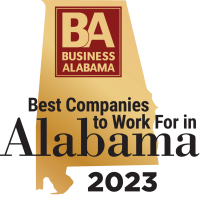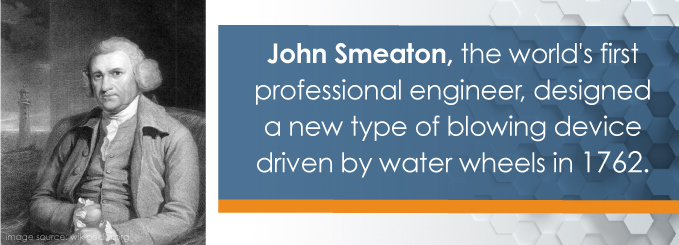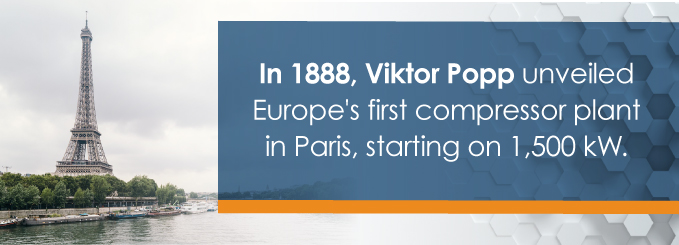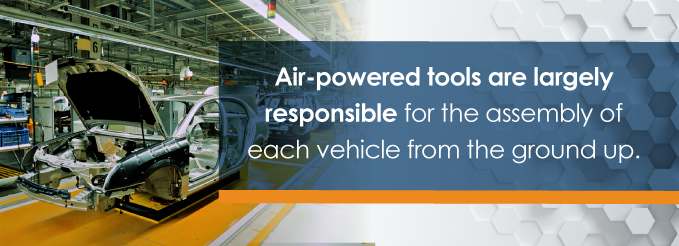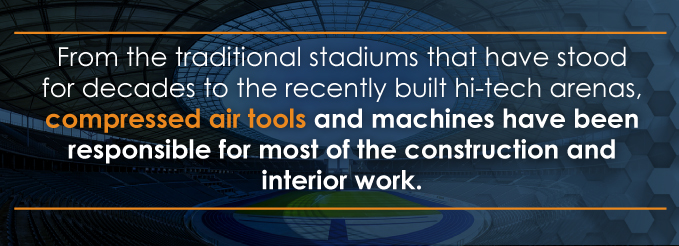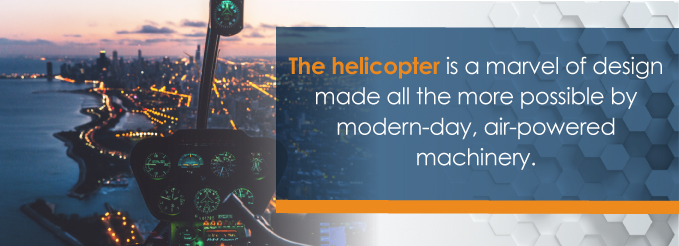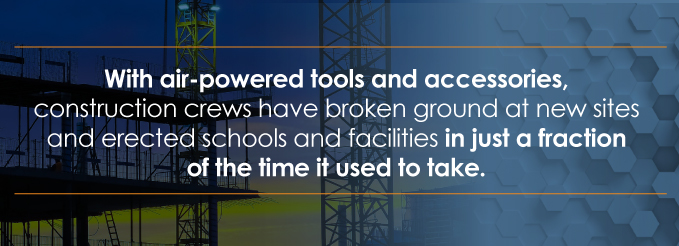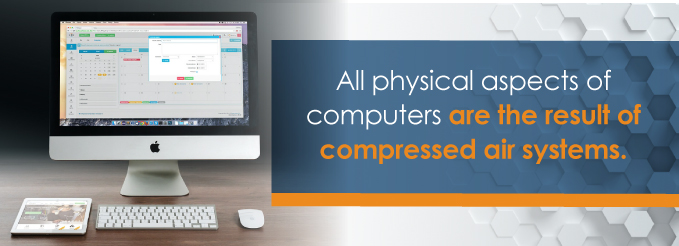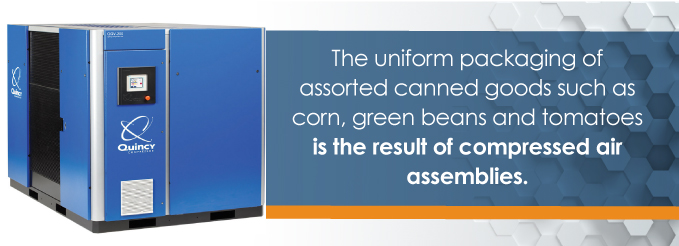Table of Contents
- Bellows: Prototype to the Air Compressor
- 1660 to 1830
- 1850 to 1900
- 20th Century
- Automobiles & Rise of Personal Mobility
- Military & Warfare Artillery
- Skyscrapers & Growth of Big Cities
- Aircraft & Commercial Flight Industry
- Suburbs & Spread of Middle Class
- Home Furnishings, Appliances & Electronics
- Food Products
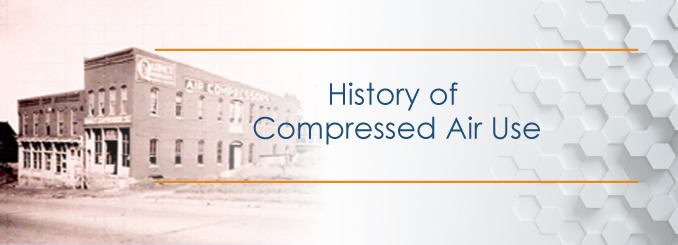
No period in human history has seen as much technological development as the 20th century. During the first half of that century alone, people witnessed the introduction of automobiles, aircraft and countless products sold in stores that hail from factory assembly lines. The production for all of these things has largely been driven by compressed air, which has made it possible for workers at factories to assemble heavy, intricate items at speeds that would have been impossible a century before.
The history of air compressor use can be traced back thousands of years to when early civilizations discovered the power of the human lung. With its ability to exhale oxygen, the lung made it easier to build fires for cooking and keeping warm.
Sometime around 3000 B.C., developments were made in the branch of science known as metallurgy, which concerns the study of metal production. Among metalsmiths, it became apparent that hotter forms of air were needed to turn liquidized minerals like copper and gold into hard metals.
In light of the demands brought on by metal production, the limitations of the human lung became readily apparent. At its healthiest, the human lung is only capable of producing a fraction of the air pressure needed for cooling metal. Furthermore, lungs proved to be an unsuitable source for fire sustenance due to the carbon dioxide content in the air that humans exhale. Clearly, something more powerful and elaborate was needed for air production.
Contact Us Learn More Find a Dealer Near You
Bellows: The Prototype to the Air Compressor
The earliest man-made air device was the blowpipe, which metallurgists in Egypt used in the production of precious metals seen in ancient tombs. This was followed by manually operated bellows — the world’s first mechanical compressed air device. Consisting of a flexible bag, the device made compressed-air production a whole lot easier. The accordion-like device sucks air in through one side while extended, then pushes the air out through the other end when the handles are squeezed together.
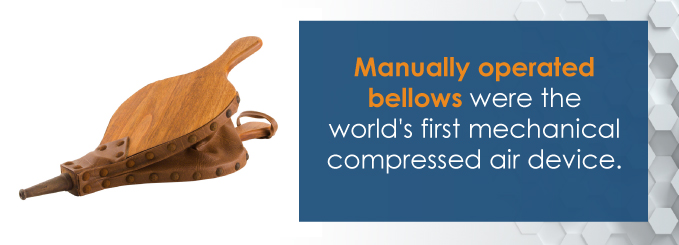
Around 1500 B.C., the introduction of foot-operated bellows — safer to operate and without the strain factor to the arms and hands — allowed for a more practical way of producing air for metalworking. Bellows remained the standard in compressed air production for the next two millenniums. Even though bellows bear little resemblance to the modern-day air compressor, they were capable of sustaining fires with enough heat to meld iron ores. Today, bellows are still used in certain applications, including breathing devices used in hospitals.
1660 to 1830: Vacuum Pumps, Blowing Devices and Blasting Units
The development of blast furnaces brought about the need for a more powerful form of compressed air. In 1650, German physicist Otto Von Guericke designed a vacuum pump that could pull gas through tiny chambers and leave compartments air free.
More than a century later, John Smeaton conceived an even more influential idea. He was the world’s first professional engineer, and in 1762, he designed a new type of blowing device driven by water wheels. This was followed in 1776 by English inventor John Wilkinson, who created a high-powered blasting unit that would serve as a precursor to the machine compressor of today.
The earliest air compressors were steam powered, and it was these devices that were used in some of the first major underwater missions, in which air was pumped to the diver so he could remain below the surface to complete assignments. By the dawn of the 19th century, engineers were employing air compressors for the purpose of energy transmission. The 1820s saw the construction of a Welsh water-based plant that utilized compressed air. It became apparent that compressed air was better than steam as a power source for heavy-duty machinery.
1850 to 1900: Pneumatic Drills and Compressor Plants
The first major construction powered by compressed air technology was for the Fréjus Rail Tunnel. Started in 1857 and completed in 1870, this eight-mile tunnel would join Italy and France through Mt. Cenis in the European Alps. The teams from both countries used pneumatic drills, along with wet compressors that were used to cool the air inside as the miners made their way deeper into the rock.
In 1888, Austrian engineer Viktor Popp unveiled Europe’s first compressor plant, starting on 1,500 kW. Situated in Paris, the plant was generating 18,000 kW by 1891. Soon enough, other inventors were moving in to patent a variety of tools and accessories that ran on compressed air.
Meanwhile, the city of Paris became the epicenter of a raging debate regarding the future of power systems, with many people arguing that compressed air would soon overtake electricity as technology moved forward.
The 20th Century: Modern Air Compressors
The early 1900s would usher in the most plentiful time in the history of air compressor use, as it was during these years that the world witnessed one innovation after another in travel and everyday living. First there was the rise of the automobile, followed swiftly by the aircraft, both of which relied on compressed air systems throughout the construction process. Simultaneously, building designs grew in scope and complexity, thanks largely to innovations in power-tool technology that made vast undertakings like the Empire State Building possible.
Automobiles and the Rise of Personal Mobility
Across all nations over the past century, nothing has changed everyday life for the average citizen more than personal transportation, which owes much of its existence to compressed air systems. From cars and vans to light rails and Greyhounds, the vehicles that populate the world’s thoroughfares are assembled at factories that are largely reliant on air-powered machines and tools:
- Cars and trucks. On everything from compacts to vans, air-powered tools are largely responsible for the assembly of each vehicle from the ground up. What begins as a set of engine and body parts is eventually built into a fully assembled and finished vehicle thanks to such equipment as pneumatic drills and spray painters.
- Buses. The production of buses is similar to that of cars, but with a lengthier and more complex series of assembly work. At various stages of construction, pneumatic tools are used to fasten together engine parts, tires and pretty much everything found in the passenger compartment.
- Trains. Though long predating the automobile, trains have become much easier to assemble since the advent of modern-day air compressors. Moreover, compressed air has proven far preferable to the steam systems of earlier times in the operation of rolling stock.
Military and Warfare Artillery
Since its first global show of strength in WWI, America has maintained one of the world’s largest and most powerful militaries. With its high-powered aircraft, tanks and weapons, the U.S. armed forces are prepared to face any threat — be it domestic or overseas — on the ground, from the sky or underwater. From one conflict to another, the power of America’s military has largely been made possible with compressed air, which plays a vital role in the following fabrication:
- Machine guns. Today’s high-powered, military assault rifles are made on assembly lines that utilize pneumatic tools for drilling at all stages. First the parts are molded into form in air-powered machines, and then they’re trimmed into shape with air-powered cutters. Finally, parts are assembled with pneumatic drills and similar tools.
- Tanks. The mightiest of all military vehicles is assembled with factory machines that are powered by air compressors. From the big, heavy panels that comprise the body to the huge nuts and bolts that hold each track in place, pneumatic tools are largely responsible for this powerful vehicle.
- Submarines. It takes an airtight vessel to sustain men underwater for hours and even days at a time. With compressed-air systems at naval manufacturing plants, today’s submarines are safer than ever for missions in the coldest and most treacherous seas.
Skyscrapers and the Growth of Big Cities
Many of the world’s most well-known cities have existed for centuries, but no period of time witnessed as much intensity of growth as the early 20th century, when air-powered machinery allowed buildings to scale heights like never before. Leading the way was the Big Apple, which outdid itself consecutively with what would long stand as the world’s two tallest buildings: the Chrysler Building and the Empire State Building. These constructions spearheaded a trend toward large, lavish urban buildings and facilities for both public and private use:
- Skyscrapers. Scaling heights of more than 100 stories and 1,000 feet requires an ingenuity to humankind has only reached within the past 85 years. To build that high, pneumatic tools are required that can rivet metal foundations into place in quickly.
- Hotels. Between the Gilded Age and the Roaring Twenties, hotels and luxury suites grew in scope and detail as architectural developments allowed for more expansive, ornate forms of construction. Of course, most of these designs could have hardly materialized without the magic of compressed air-powered machines and tools.
- Tenements. Advances in construction technology also made it easier for architectural firms to design straight, simple apartment buildings for low-income city dwellers. With pneumatic jack hammers, drills and rivets, modernist 12-story tenements were erected quickly and cheaply throughout North America.
- Stadiums and Arenas. Stadiums have become more commonplace in large and mid-sized cities as professional sports teams and top-drawing entertainment attractions make it possible to fill 10,000-plus seats. From the traditional stadiums that have stood for decades to the recently built hi-tech arenas, compressed air tools and machines have been responsible for most of the construction and interior work.
- Public monuments. These days, just about every city has its own unique monument that serves as a visual focal point in postcards. Though the tradition was initiated centuries ago, some of today’s monuments and sculptures are taking intricacy into new realms, thanks in part to the special detail work that can be more ably achieved with compressed air-powered tools.
Aircraft and the Commercial Flight Industry
No innovation has embodied man’s triumph over nature more than the art of aviation. Since its discovery in the early 1900s, the aircraft has swiftly turned the world into a much smaller place. In its first 15 years alone, air flight developed from a field experiment to a viable means of warfare. While the evolution was swift, it would be hard to imagine such progress being made without the key role compressed air plays in the construction of aircraft:
- War. From WWI onward, aircraft have played an integral role in military operations. At manufacturing plants, everything from the engine and cockpit to the wings and wheels are cut, molded, riveted, bolted and painted with air-powered tools.
- Travel. Within just a few short decades from the first transatlantic crossing by plane, commercial air travel had become big business on a global scale, which is quite amazing given the altitudes involved. Yet despite taking passengers tens of thousands of feet above the ground, air flight remains the safest way to travel. That said, the world’s supply of airplanes would hardly be as plentiful without the advantages of assembly afforded by compressed air systems.
- Helicopters. As people from all walks of life seek flights both cross-country and overseas, others do work that involves quick hops over cities and from town to town. Whether it’s used for aerial surveillance, weather forecasts or private business functions, the helicopter is a marvel of design made all the more possible by modern-day, air-powered machinery.
- Airports. Since the rise of commercial air travel, the airport has become a world unto its own where people eat, buy souvenirs and wait for departing or returning flights. In terms of layout, airports are lavish facilities that take tremendous designer ingenuity and manpower to build. Thankfully, the modern-day air compressor was developed in time to help build the airport industry from the ground up. Operations are also dependent on compressed air to maintain daily flights worldwide.
Suburbs and the Spread of America’s Middle Class
The end of WWII marked the beginning of one of the most prosperous periods in U.S. history as returning G.I.’s settled into work and family life. With advances in building design and the growing prevalence of automobiles, the stage was set for a new type of living community that was safer, cleaner and less congested than the inner cities — but also less isolated than the prairies. Thanks to the power of compressed-air arsenals, the following developments have swiftly spread over the past seven decades across lands that were once barren and desolate:
- Suburban neighborhoods. As with inner-city buildings, neighborhood homes are largely built with pneumatic drills, nailers, sanders and sprayers. Suburban development could never be as fast or efficient without tools and machinery powered by compressed air.
- Schools and recreational facilities. With air-powered tools and accessories, construction crews have broken ground at new sites and erected schools and facilities in just a fraction of the time it used to take to build such places through other means. Best of all, pneumatically built schools and buildings are proving to be more durable than their counterparts from a century earlier.
- Shopping malls. As suburbia spread, residents had less urge to drive into town for the purposes of shopping, dining and entertainment. By popular demand, construction crews were given new projects that involved taking the pneumatic tools and machines used in recent urban constructions for duplicates of those same amenities — hence the spread of suburban shopping malls, restaurants and movie theaters.
Home Furnishings, Appliances and Electronics
Compressed air has formed the backbone of production in most areas of modern life. In the same way that air-powered tools have fueled the speed at which cities have grown, suburbs have spread and aircraft and automobiles have developed over the past century, pneumatic assemblies have also been a boon for the production of everyday household items.
From the furniture that people use for dining, leisure and rest, to the items that people watch and engage with for entertainment and communication, air compressors are responsible for everything from the molding of parts to the assembly of products:
- Tables, shelves and sofas. When people imagine furniture construction, they often think of strenuous manual work. The fact is, most of today’s furniture is produced in whole or in part with pneumatic tools, which enable workers to assemble items piece by piece with simple point and activate movements.
- Stoves, refrigerators and washing machines. Appliances for the kitchen and laundry room would be tough to assemble by hand, even if 20 people were involved. Thankfully, most of the heavy lifting and complex parts assembly is done with compressed air machinery and tools on which the hardest work involves knowing which buttons to push.
- TVs and sound systems. The television boom coincided with postwar suburban sprawl and home sound systems followed soon thereafter. As with the houses and buildings, the proliferation of TV sets was enabled by air-powered tools and machinery.
- Computers and peripherals. The last two decades has seen the Internet become vital in all people’s lives, first with computers and now with handheld devices. All physical aspects of such devices — from the shaping of screens and enclosures to the fastening of parts — are the result of compressed air systems.
Food Products
Ever wonder how canned tomatoes and wrapped chocolate bars are so fresh and clean when you first open them up? It’s because of the clean way they’re packaged on assembly lines with compressed air systems. At manufacturing plants, pneumatic machinery is used to mold tin cans and plastic containers into shape, and to then fill those containers with everything from vegetables and beans to nuts and beverages. A similar yet different process goes into the packaging of candies, which are also mixed and molded into shape with air-powered machinery.
Here are some other areas of the food packaging industry that utilize compressed air:
- Jarred edibles. Every time you reach for packaged nuts or dried fruit from a plastic container, you may not know how the packaging was assembled. Everything from the container’s shape and labeling to the measurement of contents — down to the exact ounce — is done with compressed air-powered machinery.
- Canned goods. The uniform packaging of assorted canned goods such as corn, green beans and tomatoes is the result of compressed air assemblies, on which cans are precisely filled, sealed and labeled.
- Boxed cereals. The wonderful thing about cereals is how they’re fresh and ready to eat the moment you open the box, and how they remain good for many weeks after opening. All of that crisp freshness is thanks to compressed air, which makes and shapes the little cereal bits, and then packs them into plastic bags and cartons.
- Bakery items. In bakeries and grocery stores, the ingredients to all the freshly baked breads, bagels, pastries and cupcakes are mixed with air-powered cooking machinery. Compressed air is also used for the mixing and application of icings on cakes and cupcakes – not to mention the packaging.
Quincy Compressor: An Industry Leader Since 1920
The aftermath of WWI saw a boom in factory productions as manufacturers competed in the burgeoning auto and furnishings markets. It was during this period that Quincy Compressor emerged as a first-generation maker of air compressors and pneumatic tools for a full range of applications.
For nearly a century, our compressors have powered everything from the assembly of automobiles to the construction of buildings. Work crews and craftspeople alike rely upon Quincy compressors and accessories for pressurized, moisture-free compressed air on numerous applications. To learn more about our air compressors, dryers and more, visit our sales and service locator page.

